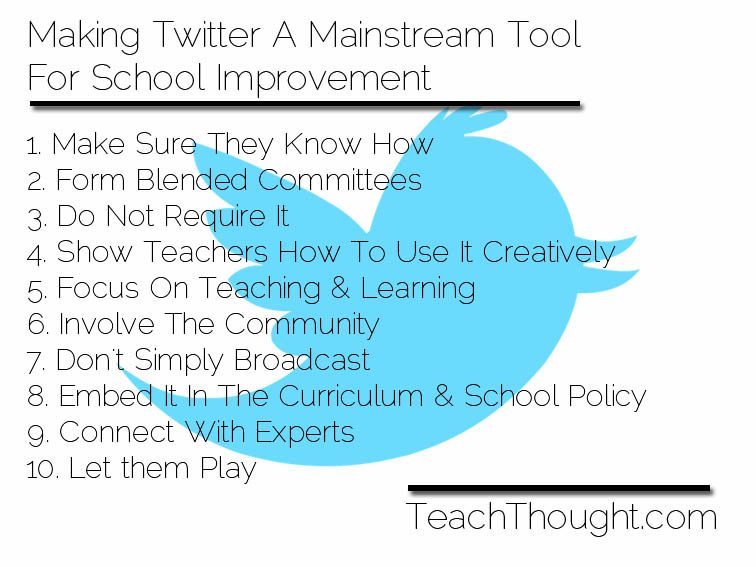
How To Make Twitter A Mainstream Tool For School Improvement
by Terry Heick,
Using twitter as a learning tool doesn’t require much imagination.
Twitter is a microblogging platform that allows people to share and skim a large quantity of ideas in a short period of time. Students can connect with experts, socialize thinking, participate in basic school-to-school collaboration, research trends and consensus, and countless other activities that lend themselves to traditional–dare I say, progressive–classroom planning.
But there are barriers that exist–either with the tool, the users, or the larger context–that keep it from being adopted as a mainstream tool for school improvement.
Twitter as a Social Media Platform
For one, it doesn’t smell academic, which scares some away. Other platforms, from virtual classrooms to Edmodo and others, are more naturally “educational,” but that’s also part of the problem: one reason twitter “works” in the classroom (insofar as it does) is because it’s authentic. People are there sharing information and ideas because they want to in both formal and recreational circumstances.
And though it’s not designed to be a tight-knit community the way your Circles on Google+ or your “friends” on facebook might be, twitter chats and “tweet-ups” have provided a clear sense of community for frequent users. In fact, its popularity might reflect a preferred interaction level, where users want to chat, exchange ideas, and applaud comments just as they do on other platforms, but at arm’s length. In a nutshell, twitter requires very little commitment or obligation.
And that might be part of the problem.
Statista recently shared that approaching half of all users who originally registered for a twitter account either don’t actively use it, or have deleted their account entirely. To better understand this statistic, it’d be more helpful to compare usage rates to social media platforms that aren’t integrated into every single area of our digital lives like Facebook strives to be. That’s like comparing the ubiquity of McDonald’s to Jersey Mike’s or Jimmy John’s. But the fact remains: People start using facebook and statistically speaking, stick with. People start using twitter, then stop.
 10 Strategies For Using Twitter A Mainstream Tool For School Improvement
10 Strategies For Using Twitter A Mainstream Tool For School Improvement
1. Make Sure They Know How
It’s simple, yes. But so are sub plans, fire drills, and parent conferences, and they all get botched from time to time. Teachers are busy. Cut them (us?) some slack.
2. Form Blended Committees
Another strategy is to create “blended committees”–combine teachers, students, and active educators and content-area folks from twitter to collaborate, vote on relevant ideas, and socialize thinking. You don’t have to give them keys to the school, but they can have a voice.
3. Do Not Require It
Instead, give them a reason to use it. Not all teachers will like it. (Is there anything teachers like universally?) If they don’t, move on. Rather than focusing on “buy-in,” instead focus on tools, thinking, and evolving how teachers collaborate and share. It doesn’t need to enjoy 100% participation to promote school improvement.
4. Show Teachers How To Use It Creatively
So they have an account, have logged-in, chosen an avatar, and listened to you explain what a #hashtag is. That doesn’t mean they can use it creatively, elegantly, or in some way that is compelling to them and their very finite amount of time.
One example? Ideas for using hashtags in the classroom.
5. Focus On Teaching & Learning
Not how avant-garde and progressive it all is.
6. Involve The Community
Give parents, district officials, community and business leaders, and other a reason to find you there. If there is no reason for the above to ever connect with you, we have a problem, yes? Which leads us to #7.
7. Don’t Simply Broadcast
Yes, twitter can broadcast and distribute content, but that rarely inspires, and certainly doesn’t invite engagement or community. Don’t simply announce snow days or upcoming field trips. Connect.
8. Embed It In The Curriculum & School Policy
In a “data-driven world,” schools work from standards, curriculum, and policy backwards. Making something a matter of “policy” is not the way to innovation or authenticity, but when in Rome: in most schools, policy drives polices everything. A tool that connects, by design, has potential in the center of the machine, rather than something tacked on.
How can a single tool become a part of learning experiences? Here are 25 ways to use twitter in the classroom to jumpstart your thinking.
9. Connect With Experts
One of the most powerful catalysts for enduring school change is empowering passionate and talented people to function in their sweet spots. This could mean content area experts (scientists on twitter, for example) and national and global education leaders.
10. Let them Play
Play is fun. Play inspires learning. Play is liberating. Play encourages innovation and promotes self-efficacy.
Here are some ideas for what teachers can do on twitter.
Data graph courtesy Statista; Making Twitter A Mainstream Tool For School Improvement